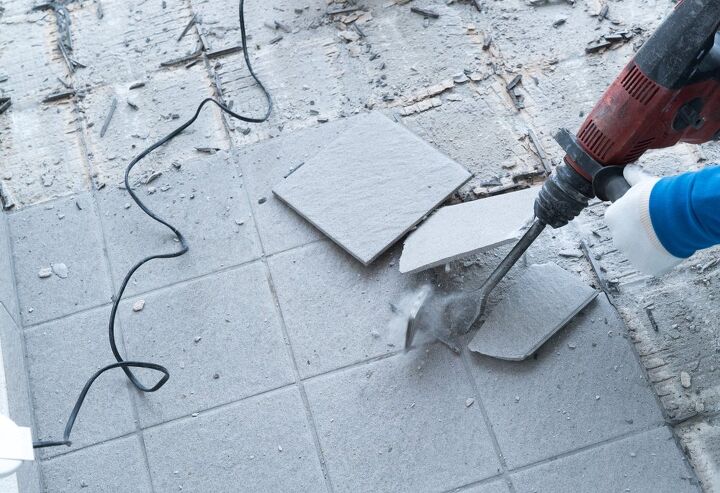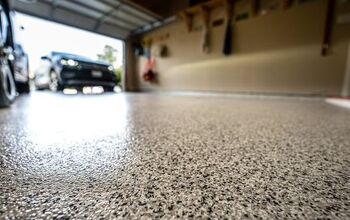How Much Does It Cost to Remove Tile Floor?

Elegantly designed tile floors can be terrific additions to any home setting. They add a touch of refined design to any room they’re used in. Tile floors are also easy to clean, thus making them practical additions for many homeowners.
Over time, tile floors can get damaged in many ways, with chips and cracks among the possibilities. The inherent beauty they possessed has now faded away and you’re left with flooring that is no longer presentable. It’s time for you to remove your existing tile floor and make way for a suitable replacement.
The cost of removing an existing tile floor amounts to $3 per square foot. You should know that factors such as your location and whether you want dust-free tile removal can change the cost per square foot number. Homeowners should also account for the cost of discarding the removed tiles properly. Expect to pay $70 for that necessary service.
Removing an existing tile floor is a major project and it’s also a necessary one. After all, you cannot start renovating your home without doing something about your damaged flooring first. Learn more about the costs attached to removing your tile floor by continuing with the rest of this article.
Do You Need to Hire a Flooring Contractor?
Get free, zero-commitment quotes from pro contractors near you.

Cost of Tile Floor Removal Per Square Foot
| Estimate Type | Cost Per Square Foot |
| Low-End Estimate | $1.50 |
| Mid-Range Estimate | $3 |
| High-End Estimate | $4.50 |
Approach a contractor if you need your damaged or outdated tile floor removed. When it comes to removing tile floors, many contractors opt to charge per square foot. The typical rate that contractors charge for this kind of project is $3 for each square foot of tile flooring removed.
A contractor may charge more for this kind of project. Don’t be surprised if a contractor tells you that tile removal will cost $4.50 per square foot.
On the opposite end of the spectrum, you can find contractors who will charge a below-average rate to remove the tiles. Look long enough and you may get a rate of $1.50 per square foot.
Even if you manage to get a low rate, the costs can still pile up. You may be wondering why this kind of project is so expensive.
It’s expensive because it’s a very labor-intensive undertaking. Removing tiles can take hours upon hours of work. It can be a test of endurance on the part of the workers you hired. Furthermore, removing tile flooring is not as simple as just destroying the tiles. If the workers do that, they could damage the subfloor underneath.
Workers must exercise a certain level of care to ensure that only the tiles are damaged. That can be tough to do especially since some heavy-duty tools may be required during tile removal.
Cost Factors for Removing a Tile Floor
The size of the tile floor is not the only factor that matters when determining the cost of this removal project. Included in this section are the other significant factors that affect the cost of tile floor removal.
Dust-Free Removal
Upon reaching out to a contractor about handling this kind of project, they may ask if you want dust-free removal. Dust-free tile removal means the workers will remove the tiles without leaving any dust particles for you to deal with.
Thanks to dust-free tile removal, you won’t have to spend a lot of time tidying up. You can lay down your new flooring faster.
Dust-free tile removal is a supplemental service. Contractors will charge a higher rate if you want it. Consider the time and resources you’ll have to invest in cleaning up to find out if dust-free removal is worth it.
Location
Location is always going to affect pricing if you’re hiring a professional to take on a home improvement project. First off, you have to consider where your home is relative to your contractor. If they have to drive a long way to reach your home, they will charge extra.
The amount of competition in your area will also affect the cost of the project. Having fewer competitors means your contractor can charge a higher rate. They don’t have to worry as much about you going to a different contractor to get a better deal.
The cost of living in your area will also influence labor costs. You can expect to pay more if you live in a city with a high cost of living.
Permits
It’s a good idea to be mindful of permits if you’re making changes of any kind to your home. You don’t want to delay the project just because you forgot to secure the necessary permits ahead of time.
Permits usually aren’t required for tile floor removal projects. Still, you should check with the relevant local offices in your area just to be sure. Your contractor can also tell you if permits will be needed. They can even help you secure those permits if they are indeed required.
Tools Required
Do you know which tools are required for tile floor removal? If you think that a hammer and chisel are the only tools required, then you are mistaken.
Workers have to use a wide array of tools to remove the tiles without damaging the subfloor. Examples of tools needed for this kind of project are hammers, air hammers, chisels, floor scrapers, and pry bars. A grout removal tool is also recommended if you want to finish the tile removal quickly.
Cost of Tile Disposal
| Estimate Type | Cost |
| Low-End Estimate | $50 |
| Mid-Range Estimate | $70 |
| High-End Estimate | $90 |
The tiles you removed don’t magically disappear. You have to dispose of them somehow or else they will clutter up your home. The average cost of throwing away the tiles is $70.
Talk to the contractor about getting rid of the tiles beforehand. Give them a heads up so they can bring their largest vehicles and the discarded tiles can be loaded onto them.
The cost of disposal will change depending on how far the landfill is from your home. Your contractor may also charge more if there are plenty of tiles to be disposed of. You don’t have to pay for tile disposal. Handling that job yourself is one of the best ways to save money on this project.
Disposing of the tiles is easy enough if you have access to a truck. With no truck available, you can still use your car as long as you’re fine with getting some debris in there.
Homeowners should know that throwing the tiles away is not the only option. Tiles that are still in good shape after removal can be donated. Reach out to charitable organizations nearby and ask if they could use your tiles. You can also sell those old tiles. Don’t expect to get much for used tiles, but the money you do receive can still offset your expenses a little.
Lastly, you can repurpose the tiles after cleaning them up. Use a manual or electric tile cutter to transform the old tiles and make them easier to handle.
After processing them carefully, old tiles can be used as trays, coasters, or even homemade jewelry. They can also help beautify your garden. Transform your garden by creating a pathway lined with tiles.
DIY vs. Professional Tile Floor Removal
You already know that your current tile floor needs to be removed. The only question is, who will be the one tasked with removal? Are you going to handle the task yourself or will you pay someone to handle it for you?
To answer those questions, let’s first consider a few things. For starters, do you have the tools to remove the tiles properly?
As noted in the previous section, various tools are required for proper tile removal. We already mentioned some of the essential tools for tile removal above. If you don’t have those tools at home, you might as well just pay for professional assistance.
You should also ask yourself if you can free up the kind of time this job requires. Depending on the size of your floor, you might find yourself removing tiles across several days. Not everyone can spare that much time. If you would rather use your time differently, you know what to do.
Homeowners should also avoid underestimating the difficulty of tile floor removal. Since you probably want to install new flooring to replace the tiles, you need the subfloor to remain in good condition.
Keeping the subfloor free from damage is not easy if you’re removing the tiles solo. You may want to hire a professional in that scenario.
Can I Install Tiles on Existing Tiles?
Removing a tile floor can be a costly project. Because of that, you may be thinking of not removing the tiles at all. Instead, you’re just going to install your new tiles over the ones currently in place.
We understand why some homeowners would rather bypass the tile removal process, but that’s not always a good idea. Even if you’re saving money now by not removing the tiles, you may still end up spending more in the future.
When you install tiles over a surface incapable of supporting them properly, you can expose your new flooring to several issues. The most concerning of those issues is shifting.
Tiles that are not firmly planted can move around when you put weight on them. If they keep moving around, they could soon crack.
The only time you can install tile over tile is if the current floor is in good condition. By good condition, we mean that the tiles and grout are intact and the floor itself is level. Do not install a new layer of tiles if your tile flooring does not match that description.
Which Tiles Are Easiest to Remove?
Some tiles are easier to remove than others. More often than not, the tiles that are already damaged in some way are the easiest to remove.
Large cracks along the face of the tile give you a spot to grip for removal. You may not have to carve into the grout anymore. You can just pry the tile loose by sticking the pry bar into the crack.
The cracks are also useful because you can use them as targets. Use a hammer and chisel on the crack and fracture the tile for faster removal. Once the tile has been broken into small pieces, you can pick those pieces out.
In terms of material composition, ceramic tiles are easier to remove compared to porcelain tiles. That’s because ceramic tiles can be broken faster. A few swings of the hammer should be enough if you’re trying to cut into ceramic tiles.
Do You Need to Hire a Flooring Contractor?
Get free, zero-commitment quotes from pro contractors near you.

Related Questions
How Much Does It Cost to Replace a Tile Floor?
The tile floor in your living room, bathroom, or garage may already be falling apart. It’s time to remove it and replace it with a new layer of tiles.Unsurprisingly, installing a new tile floor will cost significantly more than removing an old one. Expect to pay $10 per square foot if you want a new tile floor.
How Long Does It Take to Remove Tile Flooring?
Tile floor removal is not the kind of task you should just start on a whim. You need to clear out your schedule for it because it can take a while.On the low end, you might be able to finish removing the tile floor after one long day of continuous work. It’s also possible that you’ll have to work for three to four days to finish this tiring task.
Does Tile Flooring Increase Home Value?
Most of the time, tile flooring is considered an asset for homeowners. Your tile flooring will up your home’s resale value and make it more appealing to potential buyers. Tile flooring can only hurt your home’s value if you used outdated tiles.

Gary Evans is passionate about home improvement. He loves finding out how to make improvements in the easiest, most practical, and most affordable ways. Upgrading his home kitchen is one of his ongoing hobbies. Gary is also a long-time content creator and enjoys spending his free time tending to his hydroponic vegetable garden.
More by Gary Evans



























